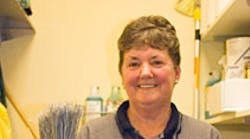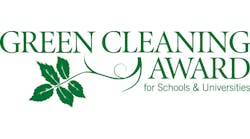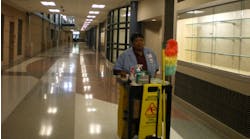Purdue University began researching green cleaning products and processes during summer 2007. After 18 months of testing and evaluation, in partnership with its residence halls and memorial union, it began phasing in the program in January 2009. By September 2009, it had converted the entire central West Lafayette campus, a process it originally had envisioned taking more than a year.
The green program is holistic in its approach. Every product used or dispensed undergoes a cradle-to-grave evaluation of its environmental impact. Similarly, when the university looks for companies to partner with, it look for ones who have taken significant steps to reduce their ecological footprint. Simply having third party-certification for their products is not enough.
The cleaning products must be readily biodegradable and come in 100 percent recycled or recyclable packaging. All of the consumables (janitorial paper and can liners) exceed the federal government's procurement guidelines (CPG) for post-consumer recycled content. Tools and supplies are all made from recycled materials or biorenewable resources — things such as mop heads made from recycled PET (soda bottles) and rapidly regrown bamboo mop handles. New capital equipment uses less water, is energy-efficient, quieter and reduces the use of chemicals. Purdue is testing electrolyzed water technology in floor care and in handheld sprayers for effective, widespread disinfection and sanitizing. The program includes hard floor care where it reduced product inventory by two-thirds, uses zinc-free finish and is focused on eliminating the use of caustic finish removers entirely.
The university has eliminated the use of butyls, phenols, solvents, aerosols and CFCs and continues to look for new products to improve or enhance effectiveness. The program has cut its chemical inventory by one-half, supply costs by one-third, and reduced solid-waste disposal and toxic effluent discharge by significant amounts.
In partnership with a chemical distributor, this year it retrained the custodial staff (315) on the new products, the new program, and the application, use and disposal of new chemicals. It explained the approach to going green directly with key people in each building, incorporated details into the Website, and put out FAQS based on feedback and questions from customers and staff. Each of nearly 1,000 restrooms on campus now has a poster announcing the program and describing its commitment to the health and safety of everyone working and studying in the buildings.
The program uses a computerized tool to evaluate the effectiveness of cleaning procedures and products, and to track efforts to improve performance.
As an adjunct to the green cleaning program, the university is introducing a recycling initiative based on desk-side collection. The results of the pilot program demonstrate a dramatic improvement. Instead of the historical two-thirds trash/one-third recycling ratio, it now is seeing one-third trash/two-thirds recycling. The full desk-side program rolls out in the spring of next year. Also beginning this year, dining courts have partnered with the local wastewater treatment plant to divert up to 20 tons of food waste into the new digester, which produces part of the electrical power used in its operation.
Learn about other Green Cleaning Award winners.
PROGRAM INFORMATION
Number of students: 40,000
Square footage maintained: 9.7 million (gross)
Number of building maintained: 132
Number of full-time custodians: 315
Green cleaning team members: Bob Morman, General Manager; Steve Benner, Howard Byers, Kristal Clark, Richard Crawford, Terri Delp, Jason Lipscomb, Chad Houston, Ed Knoth, Dave Miskin, Danny Montoya, Mike Hibbs, Supervisors; Tom Clark, Carl Carie, Maintenance; Don Blackburn, Vivian Scott, General Managers
Story of Innovation
OUTREACH: Purdue has taken its program on the road to reach out to other schols and help them jump-start their own programs. It addressed a Big Ten and Friends conference held at Michigan State University and the Midwest APPA conference held at the University of Iowa.
Learn about other Green Cleaning Award winners.



